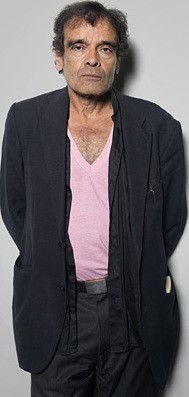
Harun Farocki. Photo: Markus J. Feger
Harun Farocki
Film and talk
10.2 2013
Stockholm
10 FEBRUARY 2013 AT 11.30 AM–5.00 PM
In the Auditorium
Admission free
Language: English
Farocki’s perspective is often directed to strategies of consulting and preparing for an event or a situation, like computer simulations, training courses or business consultancies. Employing a documentary “fly-on-the-wall”-approach without comments, interviews or soundtrack, Farocki is providing an unadorned insight into the working processes of companies or the military. (Nina Möntmann)
Programme
11.30 am
Serious Games I-IV, 2010 (45 min)
Serious Games I–IV is comprised of four distinct video installations—I: Watson is Down (2010), II: Three Dead (2010), III: Immersion (2009), and IV: A Sun with No Shadow (2010. The work positions video game technology within the context of the military, where it originated. The work juxtaposes real-life wartime exercises with virtual reenactments in order to examine the fundamental links between technology, politics, and violence. (www.moma.org)
12.15 pm
Workers Leaving the Factory, 1995 (37 min)
Workers Leaving the Factory – such was the title of the first cinema film ever shown in public. For 45 seconds, this stillexistant sequence depicts workers at the photographic products factory in Lyon owned by the brothers Louis and Auguste Lumière hurrying, closely packed, out of the shadows of the factory gates and into the afternoon sun. Only here, in departing, are the workers visible as a social group. But where are they going? To a meeting? To the barricades? Or simply home?These questions have preoccupied generations of documentary filmmakers. For the space before the factory gates has always been the scene of social conflicts. And furthermore, this sequence has become an icon of the narrative medium in the history of the cinema. In his documentary essay of the same title, Harun Farocki explores this scene right through the history of film. The result of this effort is a fascinating cinematographic analysis in the medium of cinematography itself, ranging in scope from Chaplin’s Modern Times to Fritz Lang’s Metropolis to Pier Paolo Pasolini’s Accattone!. Farocki’s film shows that the Lumière brothers’ sequence already carries within itself the germ of a foreseeable social development: the eventual disappearance of this form of industrial labor. (Klaus Gronenborn, Hildesheimer Allgemeine Zeitung, November 21, 1995)
1.00 pm
In Comparison, 2009 (61 min)
Bricks are the resonating fundamentals of society. Bricks are layers of clay that sound, like records just simply too thick. Like records they appear in series, but every brick is slightly different – not just another brick in the wall. Bricks create spaces, organize social relations and store knowledge on social structures. They resonate in a way that tells us if they are good enough or not. Bricks form the fundamental sound of our societies, but we haven’t learned to listen to them. Through different traditions of brick production Farocki’s film has our eyes and ears consider them in comparison – and not in competition, not as clash of cultures. Farocki shows us various brick production sites in their colours, movements and sounds. Brick burning, brick carrying, brick laying, bricks on bricks, no off-commentary. 20 inter-titles in 60 minutes tell us something about the temporality of working processes. The film shows us that certain production modes require their own duration and that cultures differentiate around the time of the brick. (Ute Holl)
2.00 pm Break
3.00 pm
A New Product, 2012 (35 min)
Over the period of one year Harun Farocki joined the meetings of the Quickborner Team, a business consultancy in Hamburg, as they developed a new consultancy product. The QT specialises in organisational building planning and property management (meaning the design of workspaces, offices and social zones) with the aim of optimising business processes and organisational structures. Farocki filmed the QT’s internal meetings as well as meetings with clients. The documentaion was made in close collaboration with the QT emplyees. The film focuses on the practice of future forecasting in commercial consultation at a time of upheaval, wherein consultancy is itself examining the procedures of decision-making that constitute corporate branding. (www.k-punk.abstractdynamics.org)
3.45 pm Talk
Harun Farocki talks to Stefan Jonsson, professor of ethnicity, Linköping University, and Nina Möntmann, professor of art theory and the history of ideas, The Royal Institute of Art.
In association with The Royal Institute of Art and the Goethe Institute.
The Royal Institute of Art: Nina Möntmann
Moderna Museet curators: Lena Essling, Catrin Lundqvist
